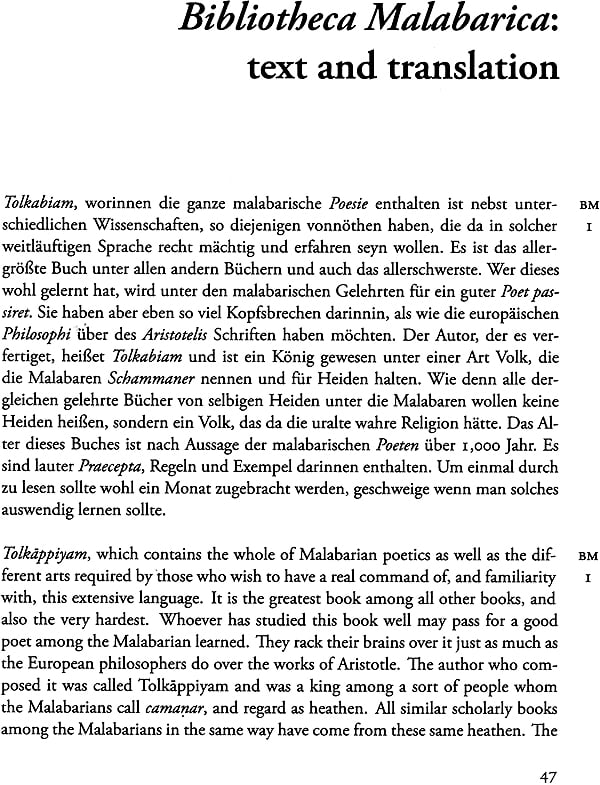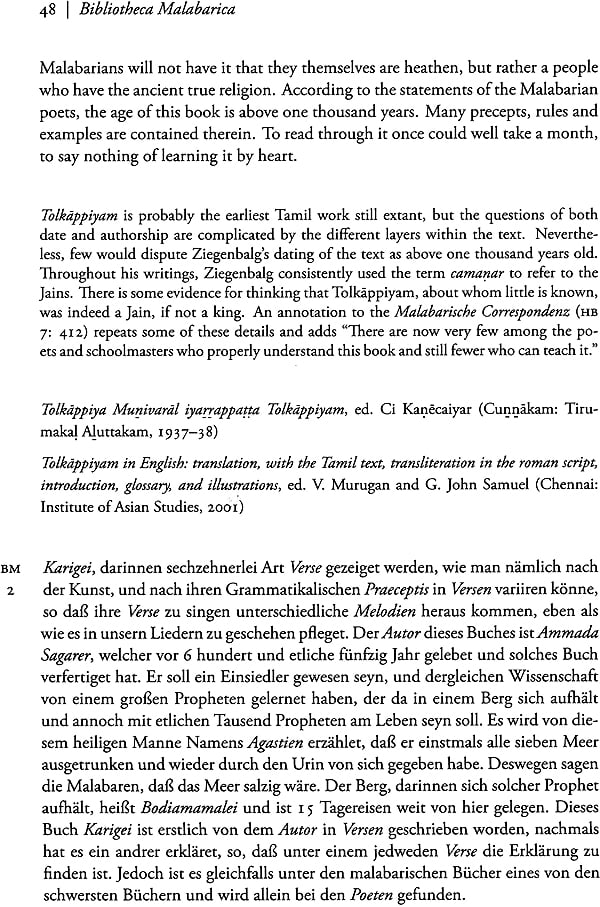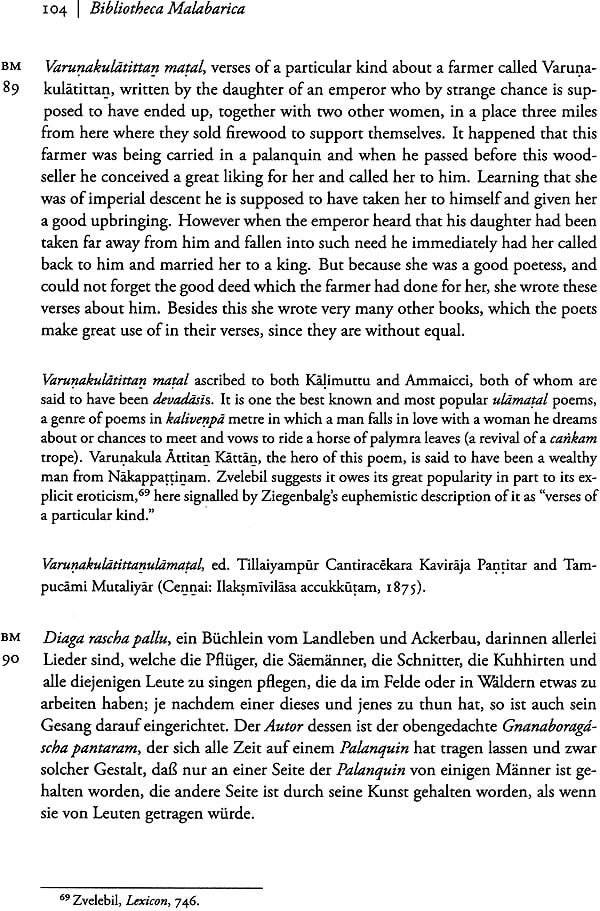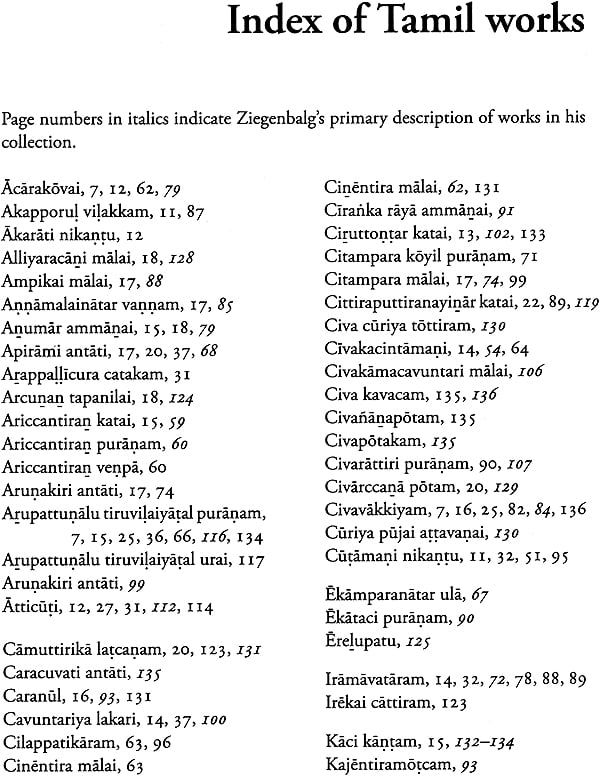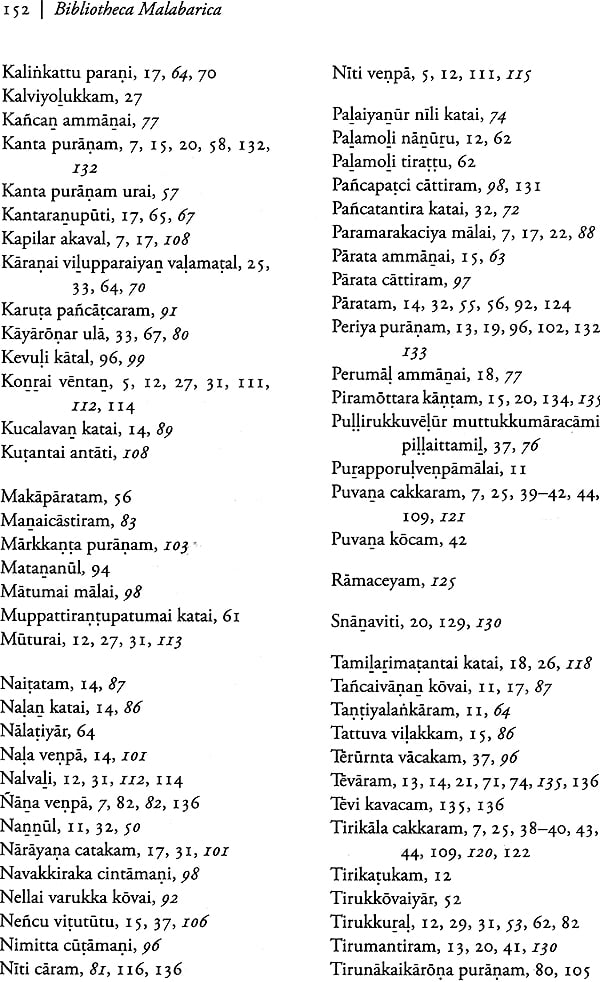
Bibliotheca Malabarica (Bartholomaus Ziegenbalg's Tamil Library)
Book Specification
| Item Code: | NAM664 |
| Author: | Will Sweetman and R. Ilakkuvan |
| Publisher: | Institut Francais De Pondichery |
| Language: | English |
| Edition: | 2012 |
| ISBN: | 9788184701920 |
| Pages: | 154 |
| Cover: | Paperback |
| Other Details | 9.5 inch x 7.0 inch |
| Weight | 330 gm |
Book Description
The Bibliotheca Malabarica is an annotated catalogue of the library of Tamil manuscripts collected by the German Lutheran missionary, Bartholomaus Ziegenbalg, during his first two years in India (1706-1708). The third section of this catalogue only will be considered here, with 119 entries covering works of Hindu and Jaina provenance. While Ziegenbalg's collection was almost entirely dispersed within a decade of his early death in 1719, his catalogue provides a fascinating insight into Tamil literary works in wide circulation on the eve of colonialism. The introduction in this volume assesses the character of Ziegenbalg's library in the context of the sources from which he obtained manuscripts. Will Sweetman's translation is then augmented by annotations which identify the works in the collection and comment on Ziegenbalg's characterisation of the texts and use of them in his own writings. It identifies for the first time one text-the Tirikala cakkaram-which was formative for Ziegenbalg's view of Hinduism from his earliest letters from India to his magnum opus, the Genealogia der malabarischen Gotter (1713). A concluding chapter considers other Tamil works mentioned in Ziegenbalg's writings after 1708.
Will Sweetman teaches Asian Religions in the Department of Theology and Religion, at the University of Otago (New Zealand). His research interests centre on interactions between the religions of Asia and the West in the modern period, particularly the study of Hinduism by Christian missionaries in the seventeenth and eighteenth centuries.
R. Ilakkuvan is a doctoral student in Tamil Studies at Tamilavel Umamahesvaranar Karanthai Arts College (Karanthai Tamil Sangam) in Thanjavur and used to be an affiliated researcher at the EFEO. His research is on the Tolkappiyam and its commentaries.
The Bibliotbeca Malabarica is an annotated catalogue of Tamil texts collected by Bartholomaus Ziegenbalg, a Protestant missionary in Tranquebar, between July 1706, when he arrived in India, and August 1708, when he sent the catalogue to Europe. The catalogue consists of 165 entries in four sections, covering Protestant, Catholic, "heathen," and Muslim works respectively. The third section is by far the longest, containing 119 entries for works of Hindu or Jaina provenance. After compiling the catalogue, Ziegenbalg continued to collect and a survey of his other works and letters reveals that he mentions in total no fewer than 170 Hindu and Jaina texts. We can be reasonably confident that Ziegenbalg had access to about 130 of the works he mentions, although it is possible-even probable-that he had other works too. Ziegenbalg's fame as a pioneering scholar of Tamil Hinduism is based almost entirely on his detailed study of these texts. Although he conversed, and corresponded, with many Hindus, and travelled to a limited extent within the Tamil region, it is above all his study of these "heathen" texts which sets him apart from his contemporaries among European writers on Hinduism.
It is the third section of Ziegenbalg's Bibliotheca Malabarica which has also been of most interest to other scholars. Kamil Zvelebil, the great Czech scholar of Tamil literature, describes this section of the work as "a relatively complete account of Tamil literature." By contrast, Hans-Werner Gensichen, a leading historian of mission, characterised it as a jumble of "grammatical and mythological works, songs and stories, philosophy and pornography, astrology and theology."The truth, perhaps, lies somewhere between the two. Ziegenbalg's collection is not representative; he has few early works and was only minimally aware of the canonical works of the Saiva and Vaisnava tradition, the Tirumurai and Ndldyira- Tivyappirapantam. The character of his collection was to some degree determined by happenstance-Ziegenbalg states that he acquired whatever books he could and certainly there were works he acquired without having read, so that he would have had to rely on others' accounts of their content. Nevertheless the collection is not entirely eclectic either. It was driven both by his own interests, and-as shall be argued here-by the nature of his connections with the Tamils who provided texts for him. If we are to evaluate Ziegenbalg's understanding of Tamil Hinduism it is crucial to be able to identify and to understand the nature of his sources. One of the problems, exemplified by the contrasting assessments of Zvelebil and Gensichen, is that scholars of Tamil literature have for the most part been relatively uninterested in Ziegenbalg's pioneering efforts, and historians of mission have lacked sufficient knowledge of Tamil literature to make an accurate assessment of them. It is our hope that, by collaborating, we have been able to over- come this problem-at least to some extent. We provide here a new translation into English of Ziegenbalg's account of Tamil literature in the third section of the Bibliotheca Malabarica, which is also the first to include all 119 entries. Following the translation of each entry, we identify the work, comment on Ziegenbalg's characterisation of it, and provide details of published editions, translations, or manuscript holdings. In the final chapter, we collect also his comments on other texts he mentions in works written after 1708.
In this introduction, we discuss Ziegenbalg's study of Tamil and his acquisition of Tamil texts. We attempt also to determine the character of the library by considering-under the heads of the major genres of Tamil literature-both the works it contained and those which it might have been expected to contain but in fact did not. After considering the fate of Ziegenbalg's library-and his catalogue of it-after his death, we assess the likely sources of his collection, and conclude by discussing the significance of his library for his account of Hinduism.
Ziegenbalg's encounter with Tamil
Ziegenbalg is renowned as the pioneer of Protestant mission in India. What has been obscured by the host of mostly hagiographical works which recount his life is how little prepared he was for that role. In August 1705 Ziegenbalg was asked whether he would accept a commission from the Danish king, Frederik IV, to go to the West Indies as a missionary. At the time he was acting as a temporary curate in a small town close to Berlin, and intending to return to university to continue the studies that had been interrupted a year earlier by his poor health and the death of his sister. Three weeks later, when in Berlin to attend a wedding, he was surprised to discover that his initial and somewhat equivocal response had been taken as an acceptance. In early October, as he set out for Copenhagen-together with his fellow missionary, Heinrich Plutschau-to be ordained, he wrote to Au- gust Hermann Francke to say that they were now to be sent to another of the Danish overseas territories in Guinea, West Africa. By the time they embarked, on 29 November 1705, the destination had changed again, now finally to the "East Indies." These details are mentioned here in order to demonstrate how little prepared Ziegenbalg was for India and its religions. There is no evidence of his having made any study of what was known of India in Europe prior to his being sent there and during the seven-month voyage the only language Ziegenbalg was able to study was Danish. Ziegenbalg mentions only one European work on Indian religion which he had read in 1706, Philippus Baldaeus's Beschreibung der ost-indishcen Kusten Malabar und Coromandel ... benebenst der Abgotterey der ost-indischen Heyden (1672).
It is, then, perhaps unsurprising that, on his arrival in India, Ziegenbalg fully expected to find barbarians. While underway to India he wrote that he was being sent to "the barbarous peoples'" and in 1708 he wrote that when he first came among the Tamils, he shared the opinion of most Europeans that they were a "truly barbaric people" without learning or morals." What is striking is how quickly his view changed, within months of his arrival in Tranquebar. Just over two months after his arrival, Ziegenbalg is already describing the Tamils as "a very intelligent and rational people," who lead a "quiet, honorable, and virtuous life," on the basis of their natural powers alone. The initial catalyst for the change in Ziegenbalg's view of the Tamils seems to have been his conversations with them, carried out in Portuguese. While Ziegenbalg reports that many people sought the missionaries out for such discussions, a key figure in shaping his early impressions was an elderly schoolmaster. From early September he held his classes in the missionaries' house, Ziegenbalg and Plurschau sitting with the children and tracing Tamil letters in the sand. While the schoolmaster spoke only Tamil, Ziegenbalg nevertheless reports daily conversations with him from before the time he began learning Tamil. The impact was immediate: "I must confess, my seventy-year-old school- master often poses such questions that I can clearly see that not everything in their philosophy can be so irrational as is fondly imagined of the heathen at home." Ziegenbalg emphasizes, however, that it was his reading of Tamil literature which completed the transformation in his view of the Tamils:
When at last 1 was entirely able to read their own books, and became aware that the very same philosophical disciplines as are discussed by scholars in Europe are quite methodically taught among them, and also that they have a proper written law from which all theological matters must be ,derived and demonstrated; all this astonished me greatly, and I developed a very strong desire to be thoroughly instructed in their heathenism from their own writings. I therefore obtained for myself ever more books, one after the other, and spared neither effort nor expense until I have now-through diligent reading of their books and through constant debating with their Bramans or priests-reached the point where I have a sure knowledge of them, and am able to give an account.
Thus it was that Ziegenbalg, less than two months after his arrival in India, began to acquire Tamil books, at first by having the schoolmaster copy them out for him. Within two years he had assembled a collection of well over a hundred Tamil texts.
The importance Ziegenbalg placed on his study of Tamil literature is clear from an account of his daily routine in a letter dated 8 August 1708. The letter was sent, with a copy of the Bibliotbeca Malabarica, to Franz Julius Lutkens, the court preacher in Copenhagen, through whom Ziegenbalg had been recruited for the mission. 17 From eight 0' clock until noon, Ziegenbalg read works new to him, in the presence of "an old poet"-most likely the same schoolmaster-who commented on and explained them. A scribe noted phrases or words new to Ziegenbalg, and a further hour each day (from seven to eight in the morning) was devoted to rehearsing the lists of words and phrases thus collected. In the afternoon, from three until five, Ziegenbalg studied systematically the works of individual authors, going through each one thoroughly before moving on to another. Once the light had faded, from six thirty to eight, Ziegenbalg had read to him-"often a hundred times"-the works of authors whose style he sought to imitate in his own works. The remainder of the day was taken up with prayer, catechising, and rest. Although the routine was interrupted almost every day by discussions with Tamil visitors-many, according to Ziegenbalg, poets who came from a distance to meet him-the fruits of this intensive engagement with Tamil literature are clear. In the same month that he finished the Bibliotheca Malabarica, Ziegenbalg completed also his translation of Ulakaniti (BM 100), Konrai ventan (BM 102), and Niti venpa(BM 105), three short didactic works. Ziegenbalg had already begun to translate into Tamil as early as 1707, but in October 1708 he began what was for him the other primary reason for his intensive study of Tamil-his translation of the New Testament (HB 6: 226, 246). This work was interrupted in November when Ziegenbalg was imprisoned as the result of a dispute with the Danish Commandant of Tranquebar, Johann Siegmund Hassius. Although he was released after a little more than four months, Ziegenbalg's relationship with the Commandant remained difficult, and the issue was only finally resolved with the appointment in 1716 of another Commandant, Christen Brun-Lundegaard.
| Introduction | I | |
| Ziegenbalg's encounter with Tamil | 2 | |
| The Bibliotheca Malabarica | 9 | |
| Ziegenbalg's library after 1708 | 20 | |
| Manuscripts of the Bibliotheca Malabarica | 23 | |
| Ziegenbalg's collection | 27 | |
| Ziegenbalg's library and his account of Hinduism | 43 | |
| A note on the format of the edition | 45 | |
| Bibliotheca Malabarica: text and translation | 47 | |
| Tamil works in Ziegenbalg's later writings | 129 | |
| Malabarisches Heidenthum | 129 | |
| Genealogia der malabarischen Gotter | 131 | |
| Bibliography | 137 | |
| Index of Tamil works | 151 |
